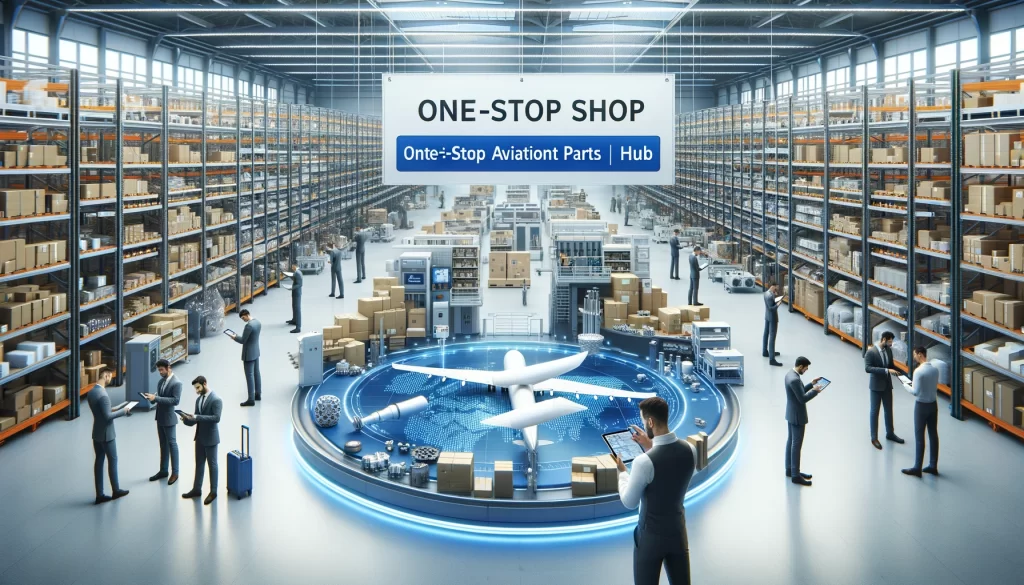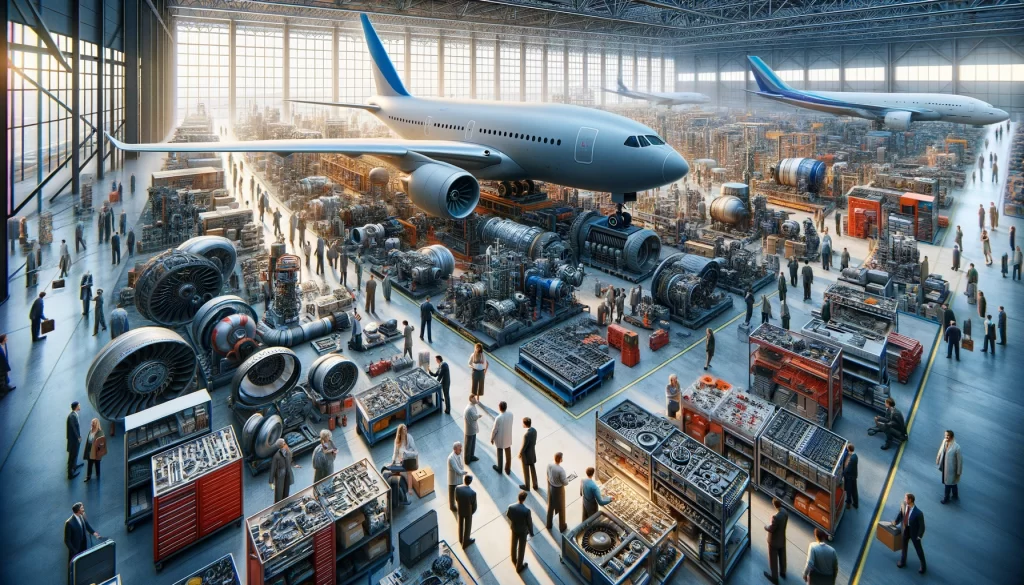Explore the transformative potential of a one-stop shop for aviation parts in Europe. This article discusses how centralizing the marketplace can streamline procurement, enhance operational efficiency, and integrate cutting-edge technologies like AI and blockchain to reshape the European aviation industry.
Introduction
The aviation industry, a cornerstone of global connectivity, relies heavily on the efficiency and reliability of its supply chains—particularly in the procurement of aircraft parts. In Europe, where the aviation market is both mature and highly regulated, the demand for a streamlined approach to sourcing aviation parts is growing. A one-stop shop for aviation parts not only simplifies the procurement process but also ensures that airlines and maintenance providers can obtain the necessary components swiftly and reliably. This article explores the transformative potential of establishing a unified aviation parts hub in Europe, focusing on how such a model could address current market inefficiencies and enhance overall industry performance.
The Current State of Aircraft Parts Supply in Europe

Market Overview
Europe stands as a significant player in the global aviation sector, hosting some of the world’s leading airlines and aircraft maintenance firms. Despite this, the region faces a fragmented market for aircraft parts, characterized by a mix of large distributors, specialized suppliers, and manufacturers. This fragmentation often leads to inefficiencies in supply chain management, including inconsistent pricing, varying levels of parts availability, and a lack of transparency in the sourcing of genuine OEM parts. Understanding this landscape is crucial for conceptualizing a more integrated solution.
Challenges in Procurement and Supply
Airlines and maintenance providers in Europe frequently encounter delays and logistical hurdles when acquiring necessary aircraft parts. One major issue is the difficulty in verifying the authenticity of OEM parts, compounded by the delays associated with cross-border transactions within the European Union, which can vary significantly due to differing national regulations and customs processes. These challenges not only increase operational costs but also impact service quality and safety standards, pressing the need for a more streamlined approach.
FAQs
- What are the key players in the European aircraft parts market?
- The European aircraft parts market includes a range of stakeholders from large distributors like Lufthansa Technik and Airbus to specialized suppliers and smaller manufacturers. This diverse ecosystem contributes to the market’s complexity and fragmentation.
- How do cross-border regulations affect aircraft parts supply in Europe?
- Cross-border regulations in Europe, including customs and import/export laws, significantly impact the aircraft parts supply chain. These regulations can vary by country, causing delays and increasing the complexity of transactions, particularly for parts that need to be moved quickly across borders.
- Why is sourcing genuine OEM parts a challenge in Europe?
- The fragmented nature of the market, coupled with the presence of numerous suppliers, makes it difficult to verify the authenticity of OEM parts. This challenge is compounded by the lack of a unified regulatory framework across the European Union to enforce standards uniformly.
The Advantages of a Unified Aviation Parts Hub

Enhanced Efficiency in Operations
A centralized aviation parts marketplace would serve as a catalyst for improved operational efficiency across the European aviation industry. By consolidating suppliers and inventory into a single platform, airlines and maintenance providers could reduce the time spent searching for and procuring aircraft parts. Such a marketplace would also enable better forecasting and planning, minimizing the risks of overstocking or understocking, which are common in decentralized supply chains.
Improved Reliability and Quality Assurance
Centralizing the supply of aviation parts in Europe under a one-stop-shop model would significantly enhance the reliability of obtaining genuine OEM parts. This model would facilitate stricter quality control measures and more robust verification processes, ensuring that all parts meet industry standards and regulations. Moreover, a unified hub could provide warranties and guarantees that are difficult to manage in a fragmented market, further boosting buyer confidence.
FAQs
- How would a one-stop shop improve procurement times for aviation parts?
- A one-stop shop would centralize the inventory, making it easier and quicker for buyers to find and purchase the necessary parts without having to contact multiple suppliers. This consolidation reduces transaction times and speeds up the overall procurement process.
- What quality assurance measures would a unified hub provide?
- A unified hub would implement stringent quality control checks and robust verification processes to ensure all parts meet specific standards and regulations. This centralized approach allows for more consistent and reliable quality assurance across all supplied parts.
- Can a one-stop shop offer warranties on aircraft parts?
- Yes, a centralized marketplace would be in a better position to offer comprehensive warranties and guarantees on parts. This setup facilitates easier management of warranty claims and ensures customer protection against defective or substandard parts.
Technological Innovations Supporting the Marketplace

Integration of Digital Platforms
Digital transformation is key to the success of a unified aviation parts marketplace. By leveraging e-commerce platforms, the marketplace can offer user-friendly interfaces that allow buyers to locate and purchase aircraft parts efficiently. These platforms can also integrate advanced features such as AI-driven recommendations, real-time inventory updates, and blockchain technology for enhanced transparency and traceability of parts.
Advancements in Logistics and Distribution
Innovative logistics solutions are essential to support the efficient distribution of aircraft parts across Europe. Automated warehousing, drone deliveries, and sophisticated tracking systems can significantly reduce delivery times and improve the accuracy of shipments. Implementing such technologies would address one of the most critical challenges in aircraft maintenance—ensuring that parts are available where and when they are needed.
FAQs
- What role does AI play in the aviation parts marketplace?
- AI can enhance the aviation parts marketplace by providing predictive analytics for inventory management, personalized purchasing recommendations based on buyer behavior and maintenance history, and automating customer service functions.
- How does blockchain technology improve parts traceability?
- Blockchain technology offers a secure, immutable ledger to record transactions, which significantly enhances the traceability and verification of aircraft parts across the supply chain. This transparency is crucial for ensuring compliance with safety and regulatory standards.
- What advancements in logistics could benefit the European aviation parts marketplace?
- Advances such as automated warehousing, drone delivery systems, and sophisticated tracking technologies could drastically reduce delivery times and improve logistical efficiency. These innovations ensure that parts are delivered accurately and promptly, reducing aircraft downtime.
Case Studies: Successful One-Stop Shops in Other Industries

Looking at sectors such as automotive and technology, the benefits of one-stop shops become evident. For instance, major automotive manufacturers have long relied on centralized suppliers to streamline parts acquisition, reducing costs and improving assembly line efficiency. Similarly, in the technology sector, companies like Apple have mastered the art of centralized supply chains to ensure quick turnaround times and high customer satisfaction. These examples provide valuable lessons for the aviation parts industry, emphasizing the potential for increased efficiency and customer satisfaction.
The Potential Impact on the European Aviation Sector

Economic Benefits
Establishing a one-stop-shop for aviation parts in Europe could significantly boost the region’s economy by creating jobs, increasing trade volumes, and fostering more competitive pricing strategies. Additionally, such a marketplace would attract investments from global aviation players and technology firms eager to tap into a more organized and efficient European market.
Enhancements in Aircraft Maintenance Efficiency
The direct impact of a streamlined parts supply chain would be most visible in the area of aircraft maintenance. Reduced downtime for aircraft waiting for parts translates into more flights and better service delivery. Moreover, maintenance providers could plan more effectively, ensuring that aircraft are serviced without unnecessary delays, thus maintaining safety and customer satisfaction.
Conclusion
The concept of a one-stop-shop for aviation parts in Europe represents a significant step forward in the quest for industry-wide efficiency and reliability. By addressing current inefficiencies, integrating innovative technologies, and drawing lessons from other sectors, this model promises to reshape the landscape of aircraft maintenance and parts supply in Europe. As the aviation industry continues to grow and evolve, the implementation of such a marketplace will be crucial in maintaining Europe’s position as a leader in global aviation standards and practices.
